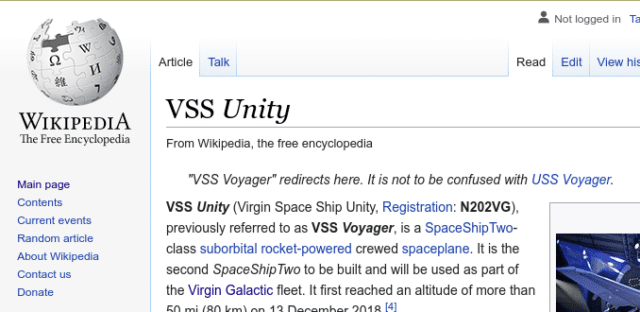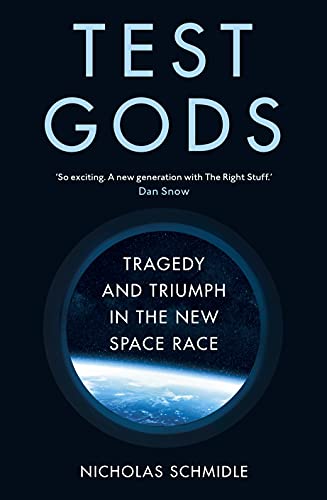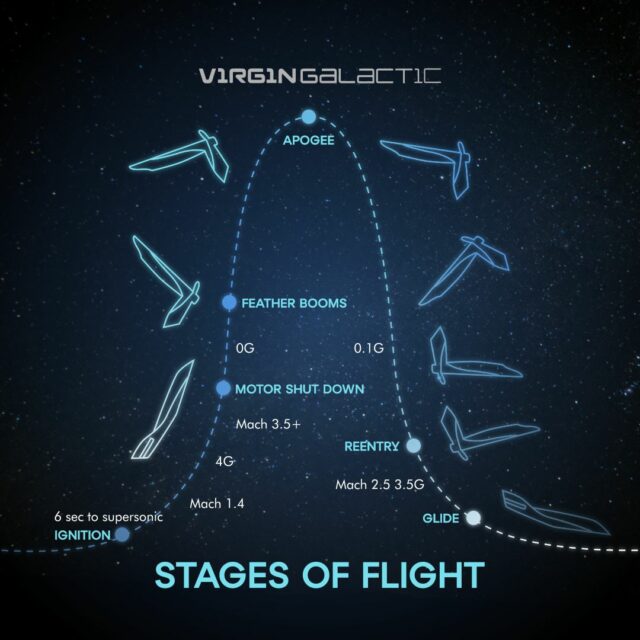VSS Unity: Trajectory Deviation at Mach 3
On the 11th of July 2021, Virgin Galactic’s space vessel, VSS Unity, was launched from the Spaceport American facility near Truth or Consequences in New Mexico, which I have to admit sounds more like a Hunter S. Thompson novel than a real place. There were two pilots and four passengers on board, including company founder, Richard Branson. The flight which reached Mach 3 speeds and an altitude of 53.5 miles was lauded as the first independent launch of a civilian into space.

Flight Unity 22 (referred to by Virgin Galactic as a mission) lasted about an hour. The sub-orbital flight spent just over three minutes above the Earth’s atmosphere, meeting the NASA definition of space as “50 miles high”, or 80 kilometres. However, it must be said that the Fédération Aéronautique Internationale, which is the international aeronautic and spaceflight body, defines space as starting above the Kármán line, which is at an altitude of 62.1 miles or 100 kilometres, which the space flight did not reach.
Although at the time, anyone who had travelled in a vehicle in space could be referred to as an astronaut, NASA and the Russian Federal Space Agency have agreed that passengers on spacecraft should not be referred to as astronauts but as spaceflight partipants. The FAA has since redefined “astronaut” to mean those on board who have “demonstrated activities during flight that were essential to public safety, or contributed to human space safety.”
The VSS in VSS Unity stands for Virgin Space Ship Unity, which had been previously known as the VSS Voyager. I don’t know why the name was changed other than potential mix-ups with USS Voyager of Star Trek fame, which, considering the first Virgin spaceship was called Enterprise seems to have been a feature, not a bug. VSS Unity was the second of its type (SpaceShipTwo) and production began in 2012. The first spacecraft, VSS Enterprise was written off after a fatal crash in 2014. VSS Unity was unveiled in February 2016 and flight testing began six months later. VSS Unity’s first suborbital flight was in December 2018.

On the 11th of July, the launch jet VMS Eve carried the space craft to 46,000 feet before releasing it to allow the crew to ignite the rocket, which propelled the craft at supersonic speeds to reach a maximum altitude of 282,000 feet (86 km or 53 miles). The rocket then shut down and the spacecraft was configured for re-entry, a gliding descent to the Spaceport American runway. The spacecraft was piloted by Dave Mackay and Michael Masucci.
And here’s where it starts to get messy. Virgin Galactic’s lead test pilot and flight test director had been Mark Stucky until he was quoted criticising Virgin Galactic’s management in Test Gods: Virgin Galactic and the Making of a Modern Astronaut, a book by Nicholas Schmidle about the test pilots of the Virgin Galactic space program. Schmidle says that the pilot was stripped of his flight duties and excluded from key planning meetings after the book was released in May 2021.

Stucky refers to leaving Virgin Galactic on Twitter but the news that he was fired over Zoom wasn’t public until an article by Nicholas Schmidle in the New Yorker on Wednesday which has taken the space world by storm: The Red Warning Light on Richard Branson’s Space Flight in which Schmidle claims that the suborbital flight July should have been aborted after the spacecraft drifted off-course during the ascent.
On July 11th, nearly a minute into the rocket trip carrying Richard Branson, the British billionaire, to space, a yellow caution light appeared on the ship’s console. The craft was about twenty miles in the air above the White Sands Missile Range, in New Mexico, and climbing, travelling more than twice the speed of sound. But it was veering off course, and the light was a warning to the pilots that their flight path was too shallow and the nose of the ship was insufficiently vertical. If they didn’t fix it, they risked a perilous emergency landing in the desert on their descent.
Schmidle explains that the trajectory problem was specifically with what is called the entry glide cone. In aviation, we talk about stabilised approaches on the glide path: following a line with a specific angle and descent speed to a landing point. In a powered aircraft, especially if there is an instrument landing system, it can be easy to aim for a specifying landing point by following a specific slope at a specific speed. However, the SpaceShipTwo model glides to the runway as opposed to a powered approach. If you consider the glide path not as a specific line drawn from the aircraft to the landing point but an area with an upper and lower limit, then you can see that it would have the shape of a cone, where the upper and lower margins reduce as you approach your landing point. In a perfect world you’d be in the middle of the cone but it doesn’t matter if you are a bit higher or lower, as long as you stay within it.

VSS Unity has one minute of power as it travels at supersonic speed and thus the entry glide cone starts there, while it still has power, in order to follow the trajectory for a controlled descent back to land.
On the 11th of July, a yellow caution light appeared, warning of a trajectory problem: the spacecraft wasn’t flying steeply enough to remain within the glide cone. Then, in the last seconds of the spacecraft’s powered flight, an entry glide-cone warning appeared as a red light on the console. Schmidle wrote about his understanding of the issue:
I once sat in on a meeting, in 2015, during which the pilots on the July 11th mission—Dave Mackay, a former Virgin Atlantic pilot and veteran of the U.K.’s Royal Air Force, and Mike Masucci, a retired Air Force pilot—and others discussed procedures for responding to an entry glide-cone warning. C. J. Sturckow, a former marine and nasa astronaut, said that a yellow light should “scare the shit out of you,” because “when it turns red it’s gonna be too late”; Masucci was less concerned about the yellow light but said, “Red should scare the crap out of you.” Based on pilot procedures, Mackay and Masucci had basically two options: implement immediate corrective action, or abort the rocket motor. According to multiple sources in the company, the safest way to respond to the warning would have been to abort.
The FAA is quoted in the article and released a statement later that day confirming that the VSS Unity had flown outside of its designated airspace for one minute and forty-one seconds.
The FAA is responsible for protecting the public during commercial space transportation launch and reentry operations. The FAA is overseeing the Virgin Galactic investigation of its July 11 SpaceShipTwo mishap that occurred over Spaceport America, New Mexico. SpaceShipTwo deviated from its Air Traffic Control clearance as it returned to Spaceport America.
The day after the article, the FAA, reacting rather more quickly than they did to the Boeing 737 MAX, announced that the SpaceShipTwo type is grounded until an investigation into the flight has completed.
Schmidle has been reporting on Virgin Galactic for half a dozen years and appears to have a strong understanding of both the mechanics of the space craft and the politics at the company. That said, it would be remiss not to acknowledge that breaking a major story about Virgin Galactic will do much to promote both his name and his book, even if the situation on the spacecraft was not as dangerous as he claims.
That is Virgin Galactic’s defence, that the gliding descent was not dangerous. Although they agree that VSS Unity flew outside of the designated airspace, they have pointed out that there were FAA representatives in the control room during the flight. They claim that the New Yorker article contains “misleading characterizations and conclusions” and that there was no reason for the pilots to abort. “At no time did the ship travel above any population centers or cause a hazard to the public,” they added in a later statement.
Space | Pilots saw ‘red light’ warning during Virgin Galactic’s historic spaceflight with Richard Branson quotes a statement by Virgin Galactic officials:
Unity 22 was a safe and successful test flight that adhered to our flight procedures and training protocols. When the vehicle encountered high altitude winds which changed the trajectory, the pilots and systems monitored the trajectory to ensure it remained within mission parameters. Our pilots responded appropriately to these changing flight conditions exactly as they have been trained and in strict accordance with our established procedures.
Although the flight’s ultimate trajectory deviated from our initial plan, it was a controlled and intentional flight path that allowed Unity 22 to successfully reach space and land safely at our Spaceport in New Mexico,” the statement adds. “At no time were passengers and crew put in any danger as a result of this change in trajectory.
Mark Stucky disagrees:
The most misleading statement today was @virgingalactic’s. The facts are the pilots failed to trim to achieve the proper pitch rate, the winds were well within limits, they did nothing of substance to address the trajectory error, & entered Class A airspace without authorization.
— Mark "Forger" Stucky (@Stuck4ger) September 2, 2021
Schmidle’s New Yorker article is compelling in its details:
Although Mackay and Masucci attempted to address their trajectory problem, it wasn’t enough. And now they were accelerating to Mach 3, with a red light glowing in the cockpit. Fortunately for Branson and the three other crew members in the back, the pilots got the ship into space and landed safely. But data retrieved from Flightradar24 shows the vehicle flying outside its designated airspace.
VSS Unity’s next suborbital flight was, Unity 23, was planned for late September/early October with three paying members of the Italian Air Force and the National Research Council on board. However, that is now on hold pending the results of the FAA investigation. Virgin Galactic have said they are cooperating fully with the FAA but have not commented specifically on the trajectory deviation, other than they are working to determine how to prevent them from occurring on future missions.








Some are enthusiasts, other people are of the opinion that the world has one mad. Mega-billionaires do not pay taxes on incomes that are absurd and obscene and are more concerned with glamour playthings, extremely expensive projects to enhance their status. Many think that they should be forced to pay income tax like most of us, and contribute to solve more urgent needs like housing, health care, education.
But here we are. Multi-billionaires send themselves and a few ultra-rich passengers into space for their glorification.
Whatever the real situation: Real danger or a warning light, causing a problem that was handled expertly by the crew. It does not matter.
What I wonder: There used to be regulations prohibiting taking paying passengers into the air (or space) on what is in fact a test flight with a largely untested prototype.
Have the FAA waved those rules to accommodate the mega rich?
Virgin were cleared for commercial flights into space in June: https://interestingengineering.com/virgin-galactic-cleared-by-faa-for-commercial-flights-space
Voyager is a NASA program. Wikipedia says:
Voyager 1 is currently the farthest away from us of all the man-made objects we’ve sent into space.
I like to think they gave Branson the option to name his craft “Voyager 3”, and he declined, but that’s just speculation on my part.
Rudy wrote: “There used to be regulations prohibiting taking paying passengers into the air (or space) on what is in fact a test flight with a largely untested prototype.”
None of the participants in this flight were paying passengers or even, at least theoretically, passengers; all were put forward as crew members. E.g., Branson’s role was said to be something like “evaluation of the spaceflight experience”. Wink, wink. The others were company employees flying as part of their jobs.
It wasn’t dangerous, but they busted their clearance, and they’re gonna get a whuppin’ just like anyone else that busts ATC clearances.
Rudy: These aren’t untested prototypes any more. Just like the SpaceX Dragon, they’ve gone through a testing program and the FAA concurs that they’re ready for passengers.
Also, air travel has always been for the mega-rich until recently. I don’t expect for space travel to be any different. Look at any historical pictures of air travel before deregulation in the ’70s. I’m old enough to remember when a plane trip was a luxury experience in itself, not just a means to get to your vacation.
I’m too old to hold on to my hopes of it becoming cheap enough for me to do it (as with air travel) but I can still dream. Hell, I recently entered drawings that had a VG “spaceflight” as the prize and I tried for the Dragon flight too.
“Also, air travel has always been for the mega-rich until recently.”
Not exactly recently; 60 years ago, Europe on $5 a Day was recommending air travel as a cheap way to see a lot of sights. Granted, that was after 3-4 decades of commercial air travel — but the prices were never so high as to limit travel to the “mega-rich”; otherwise it wouldn’t have developed.
Space, OTOH, requires such huge amounts of energy to reach that it’s unlikely ever to be accessible even to the merely well-off — unless we get a breakthrough in materials tech and can produce space elevators (as in, e.g., Clarke’s The Fountains of Paradise). It was a nice dream, back when an author with a hard-science degree could estimate the cost of a ticket to the Moon at $30 per pound of body weight (something like $500-$1000/# today).
Interesting to read about the deviation; somehow that didn’t make it into the news sources I follow.
Thanks! It was new to me too but I was actually somewhat nervous that everyone but me already knew all about it.
My goodness. The experts of semantics were doing overtime.
But anyway, if you are a mega-billionaire you may rest assured that the law will accommodate your intentions, if necessary retrospectively.
And in the event that this does not work it is always easy to find a few top lawyers to put things right – for an appropriate fee.
What I find a bit objectionable is that the world is facing many problems that are requiring urgent attention. Increasing pollution, climate change, a pandemic, a housing crisis, a refugee crisis, a health crisis.
There are many problems that need extremely urgent attention.
Yet we sit by and calmly watch crisis after crisis unfold whilst a few already very rich people build world-wide monopolies, stuff their bank accounts with obscene profits (some of them see their wealth increase by multiple billions per month) whilst they enjoy virtual freedom of income tax. And instead of putting their wealth to work for the common benefit – as their tax-free status would actually demand as a matter of social obligation – they are using it for extremely expensive playthings, toys for themselves and their aggrandisation.
Yes, it is quite an achievement to privately fund a space ship and successfully launch it. But would it not have been preferable if that money were used to help building a better world first?